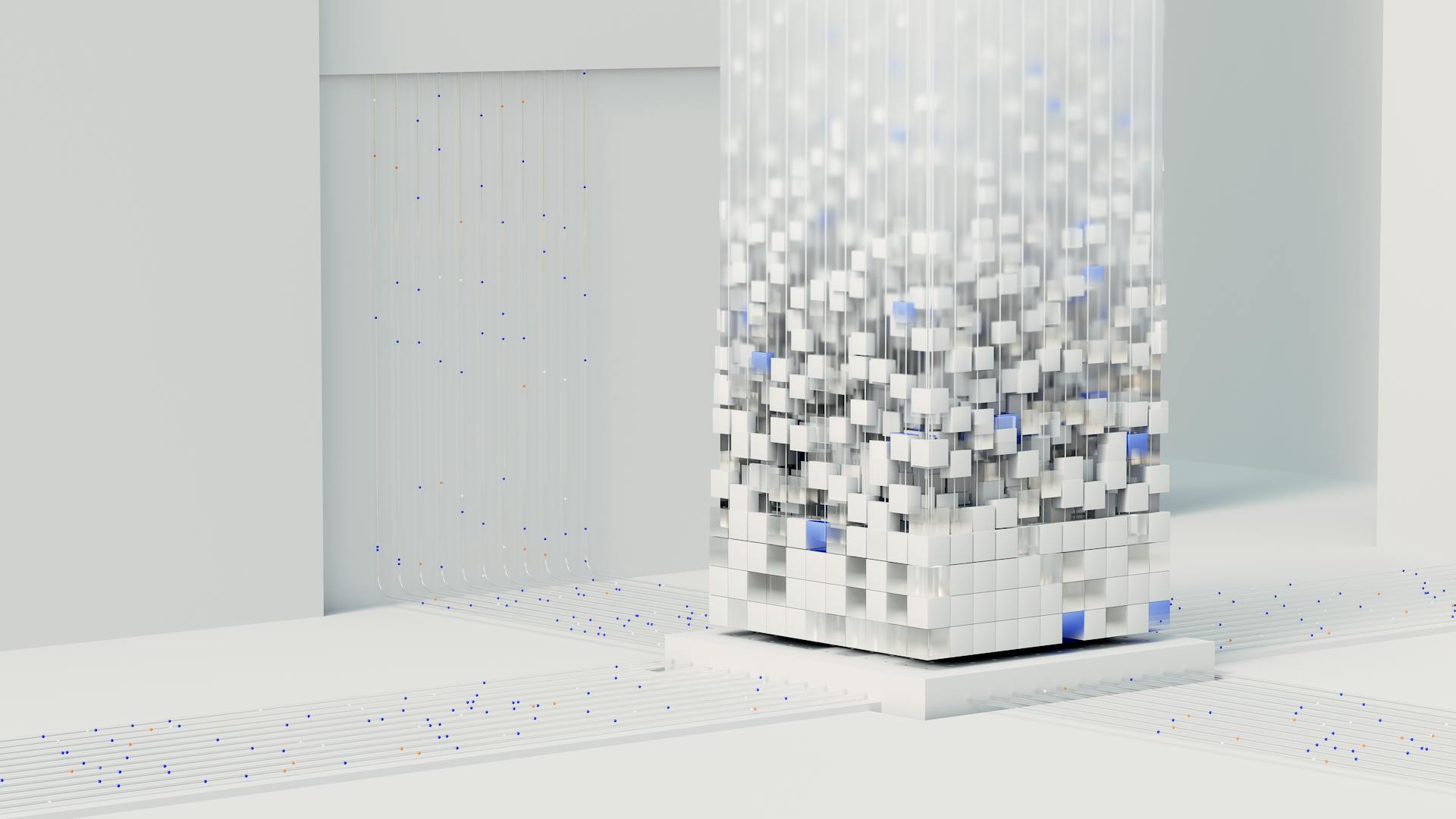
Grokking machine learning fundamentals is key to creating better solutions. It involves understanding the basics of machine learning, including supervised and unsupervised learning, and the different types of machine learning models.
In supervised learning, the algorithm learns from labeled data, which is data that has been classified or categorized. This type of learning is useful for tasks like image classification and sentiment analysis.
The goal of unsupervised learning, on the other hand, is to find patterns or relationships in unlabeled data. This type of learning is useful for tasks like customer segmentation and anomaly detection.
Machine learning models can be classified into different types, including linear regression, decision trees, and neural networks.
You might enjoy: Grokking Data Structures
Effective Theories and Representation
Effective theories have been proposed to explain the dynamics of representation learning, particularly in the context of grokking. One such theory, inspired by physics, provides a simplified yet insightful picture of how the network learns to represent the data.
The toy model, which learns the addition operation, is a key component of this theory. It maps input symbols to trainable embedding vectors, which are then summed and passed through a decoder network. The embedding vectors form a structured representation, specifically parallelograms, when the network generalizes.
A structured representation is crucial for generalization, and the Representation Quality Index (RQI) measures the quality of the learned representation. A higher RQI indicates a more structured representation, leading to better generalization.
The effective theory also proposes a simplified loss function that encourages the formation of parallelograms, driving the network towards a structured representation. This loss function is a key component of the theory, as it helps the network learn to generalize.
The theory predicts a "grokking rate", which determines the speed at which the network learns the structured representation. This rate is inversely proportional to the training time required for generalization.
Here's a summary of the key components of the effective theory:
The effective theory also predicts a critical training set size below which the network fails to learn a structured representation and thus fails to generalize. This explains why the training time diverges as the training set size decreases.
For your interest: Ai and Machine Learning Training
Deep Learning Techniques
Grokking is a fascinating phenomenon that challenges our understanding of deep learning.
Grokking is not just limited to simple toy models, but can also be observed in more complex architectures like transformers.
Researchers Power et al have demonstrated grokking in transformers trained on modular addition, where generalization coincides with the emergence of circular structure in the embedding space.
This suggests that grokking is a more general phenomenon than previously thought, and can be applied to a wide range of deep learning models.
By carefully adjusting the training set size and weight initialization, researchers Liu et al have also induced grokking in a simple MLP on mainstream benchmark datasets like MNIST.
This has significant implications for our understanding of deep learning and the development of more powerful, efficient, and interpretable models.
The discovery of grokking has the potential to unlock new frontiers in deep learning, paving the way for more advanced and effective AI models.
Explore further: Grokking Deep Learning
Weight Decay and Optimization
Weight decay can be interpreted in Bayesian terms as a zero-mean Gaussian prior for each weight, which makes sense because the strength of the weight decay is directly related to the precision of the prior.
The weight decay update can be expressed as the gradient of a log probability, where the weight is drawn from a Gaussian distribution with a mean of 0 and a variance of σ^2. This is a key insight that helps us understand why weight decay is effective in improving performance.
By adding weight decay to the decoder, we effectively reduce its capacity, preventing it from overfitting the training data too quickly. This allows the representation learning process to catch up and form a structured representation that enables generalization.
The weight decay coefficient α is directly related to the precision of the prior, with a higher α indicating a stronger prior and a lower α indicating a weaker prior. This relationship is crucial for understanding how weight decay affects the learning dynamics.
Applying weight decay to the decoder in transformers can significantly reduce generalization time and even eliminate the grokking phenomenon altogether. This is a powerful technique for de-grokking and achieving comprehension in neural networks.
Modular Addition and Learning
Grokking modular addition can be a challenging task, but it's a great example of how neural networks can learn to solve complex problems.
The model's architecture is surprisingly simple, consisting of a one-layer MLP with 24 neurons, and the weights are initially quite noisy but start to exhibit periodic patterns as accuracy on the test data increases.
As the model trains, it begins to generalize and move away from a memorizing solution, which is a key aspect of grokking.
The weights of the model exhibit periodic patterns, suggesting that the solution might be related to the model's ability to generalize.
By grouping the neurons by how often they cycle at the end of training, we can see that the model is learning some sort of mathematical structure.
The model's ability to learn periodic patterns is a key feature of grokking, and it's something that we can leverage to improve our understanding of how neural networks learn.
Discover more: Action Model Learning
With just five neurons, the model finds a solution with perfect accuracy, and the trained parameters show that all the neurons converge to roughly equal norms.
The model's solution is based on a clever construction that places the inputs on a circle, and the weights of the model are evenly distributed around the circle.
The rotation of the weights is a key feature of the model's solution, and it's something that we can use to our advantage when trying to grok modular addition.
By using the discrete Fourier transform (DFT), we can isolate the frequencies of the model's weights and see how they relate to the periodic patterns.
The DFT shows that the model's weights are equivalent to a constructed solution with a single frequency, which is a key insight into how the model is learning.
Open Questions and Future Directions
Grokking is a complex and multifaceted concept, and as researchers continue to explore its intricacies, many open questions remain.
One of the main areas of inquiry is understanding the role of optimization in shaping the learning dynamics and influencing generalization. This is a crucial aspect of grokking, and researchers are still working to refine our understanding of its impact.
The traditional view of generalization as simply memorizing training data is being challenged by grokking, highlighting the importance of learning structured representations that capture the underlying patterns of the task.
Researchers are investigating the connections between grokking and other deep learning phenomena, such as double descent and neural collapse. This could lead to new insights and a deeper understanding of how grokking works.
The effective theory of grokking is still being refined, and researchers are working to capture more complex learning dynamics and provide more accurate predictions. This will be an important area of research in the future.
Implicit regularization, such as weight decay and dropout, plays a significant role in shaping the learning dynamics and influencing grokking. Researchers are investigating its role in more detail.
Here are some of the key open questions and future research directions in the field of grokking:
- Exploring grokking in other domains, such as natural language processing and computer vision, to understand its generality and potential applications.
- Developing more powerful effective theories to capture more complex learning dynamics and provide more accurate predictions.
- Understanding the role of implicit regularization in shaping the learning dynamics and influencing grokking.
- Connecting grokking to other deep learning phenomena, such as double descent and neural collapse.
Coding and Interview Patterns
Coding and interview patterns are essential skills to master for anyone looking to crack coding interviews. There are 509 lessons in the Grokking the Coding Interview Patterns course, covering various topics such as two pointers, fast and slow pointers, and sliding windows.
The course content includes 20 lessons on two pointers, which is a common strategy for solving problems involving arrays and linked lists. Fast and slow pointers are also covered in 17 lessons, which is a technique used to solve problems involving linked lists and arrays.
Sliding windows, merge intervals, and in-place manipulation of a linked list are other coding patterns that are essential to learn. There are 12 lessons on sliding windows, which is a technique used to solve problems involving arrays and strings.
Knowing what to track is also an important coding pattern, and the course covers 22 lessons on this topic. Union find, custom data structures, and bitwise manipulation are other coding patterns that are covered in the course.
Coding patterns include approaches like two pointer techniques, sliding windows, backtracking, greedy algorithms, and dynamic programming. These patterns help efficiently tackle various algorithmic challenges.
The course offers instant code feedback, AI-powered mock interviews, and adaptive learning to help students improve their coding skills.
Discover more: Grokking the Coding Interview
The Solution
Grokking the coding interview process involves identifying patterns in problems to make it more organized and fun. This can be achieved by focusing on similar algorithmic techniques.
Following a specific data structure, like Arrays or LinkedList, still lacks coherence as many questions require different techniques.
The problem-solving patterns like Sliding Window, Fast and Slow Pointers, or Topological Sort, etc. help map a new problem to an already known problem.
These patterns can be used to solve dozens of problems and make a real difference in the coding interviews.
Here are 25 coding problem patterns that can help learn these beautiful algorithmic techniques:
- Sliding Window
- Two Pointers
- Fast & Slow Pointers
- Merge Intervals
- Cyclic Sort
- In-place Reversal of a LinkedList
- Tree Breadth-First Search
- Tree Depth First Search
- Two Heaps
- Subsets
- Modified Binary Search
- Bitwise XOR
- Top 'K' Elements
- K-way Merge
- 0/1 Knapsack
- Unbounded Knapsack
- Fibonacci Numbers
- Palindromic Subsequence
- Longest Common Substring
- Topological Sort
- Trie Traversal
- Number of Island
- Trial & Error
- Union Find
- Unique Paths
Frequently Asked Questions
What is the phenomenon of grokking?
Grokking is a phenomenon where a neural network's performance suddenly improves on a test set after an initial overfitting phase, where it perfectly fits the training data. This sharp rise in accuracy is a complex and not fully understood phenomenon in machine learning.
Sources
- https://medium.com/@ayoubkirouane3/grokking-a-deep-dive-into-delayed-generalization-in-neural-networks-e117fdef07a1
- https://www.beren.io/2022-01-11-Grokking-Grokking/
- https://pair.withgoogle.com/explorables/grokking/
- https://www.educative.io/courses/grokking-coding-interview
- https://dev.to/arslan_ah/grokking-leetcode-a-smarter-way-to-prepare-for-coding-interviews-5d9d
Featured Images: pexels.com


